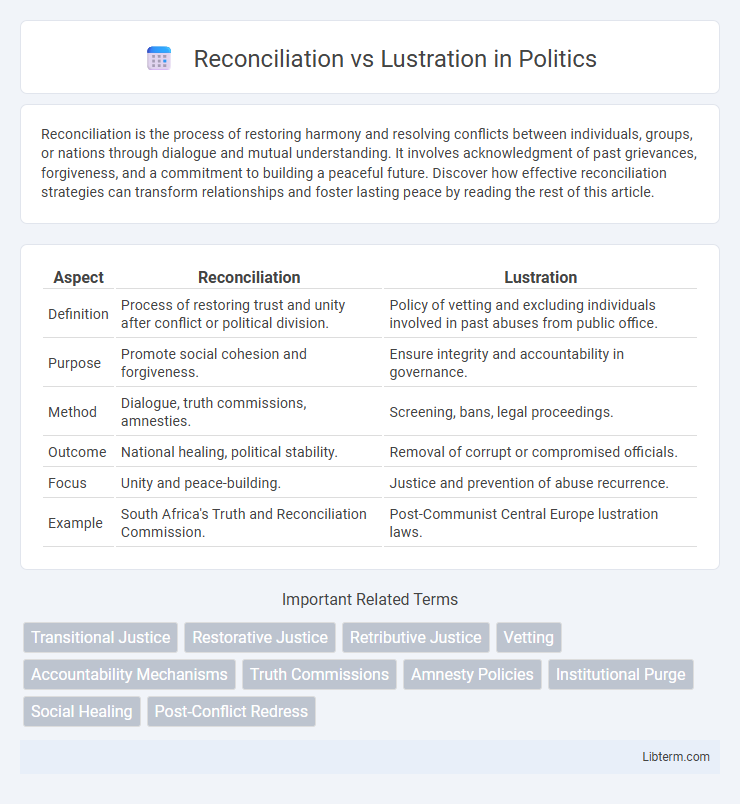Reconciliation is the process of restoring harmony and resolving conflicts between individuals, groups, or nations through dialogue and mutual understanding. It involves acknowledgment of past grievances, forgiveness, and a commitment to building a peaceful future. Discover how effective reconciliation strategies can transform relationships and foster lasting peace by reading the rest of this article.
Table of Comparison
| Aspect | Reconciliation | Lustration |
|---|---|---|
| Definition | Process of restoring trust and unity after conflict or political division. | Policy of vetting and excluding individuals involved in past abuses from public office. |
| Purpose | Promote social cohesion and forgiveness. | Ensure integrity and accountability in governance. |
| Method | Dialogue, truth commissions, amnesties. | Screening, bans, legal proceedings. |
| Outcome | National healing, political stability. | Removal of corrupt or compromised officials. |
| Focus | Unity and peace-building. | Justice and prevention of abuse recurrence. |
| Example | South Africa's Truth and Reconciliation Commission. | Post-Communist Central Europe lustration laws. |
Understanding Reconciliation: Definition and Objectives
Reconciliation involves restoring trust and harmony between conflicting parties by addressing past grievances and promoting mutual understanding. Its objectives include acknowledging wrongdoings, fostering forgiveness, and enabling social cohesion to prevent future conflicts. The process emphasizes healing relationships rather than punitive measures, contrasting with lustration's focus on political and legal accountability.
What is Lustration? A Brief Overview
Lustration refers to the official process of screening and barring individuals associated with previous authoritarian or communist regimes from holding public office or positions of power. This practice aims to promote political transparency and prevent former oppressive figures from influencing new democratic institutions. Lustration often involves the review of personal files and background checks to identify those implicated in past abuses or corrupt activities.
Historical Origins of Reconciliation and Lustration
Reconciliation traces its roots to post-conflict societies seeking to restore social harmony and heal collective wounds through dialogue and truth-telling mechanisms. Lustration originated in Central and Eastern Europe after the fall of communist regimes, implemented as legal purges to vet and exclude former regime collaborators from public office. Both processes emerged from distinct historical contexts aimed at addressing past injustices but apply different methods: reconciliation emphasizes societal healing, while lustration focuses on political accountability and exclusion.
Key Differences Between Reconciliation and Lustration
Reconciliation focuses on restoring social harmony through dialogue, forgiveness, and inclusivity after conflict or political change, while lustration involves the systematic vetting and exclusion of individuals associated with past abuses or authoritarian regimes. Key differences include reconciliation's emphasis on healing and unity versus lustration's emphasis on justice and accountability by purging compromised officials from public office. Reconciliation promotes collective memory and social cohesion, whereas lustration prioritizes legal and institutional reforms to prevent recurrence of human rights violations.
Case Studies: Successful Reconciliation Processes
Successful reconciliation processes in post-conflict societies often emphasize truth-telling, reparations, and inclusive dialogue, as demonstrated by South Africa's Truth and Reconciliation Commission, which facilitated national healing through public testimonies and amnesty provisions. In contrast, lustration policies, such as those implemented in Central and Eastern European countries after the fall of communism, prioritize the removal of former regime affiliates from public office to prevent recurrence of abuses but sometimes risk deepening societal divisions. Case studies reveal reconciliation approaches foster long-term social cohesion by addressing historical grievances, while lustration focuses on accountability and institutional reform to ensure political transparency and trust.
Case Studies: Lustration in Post-Conflict Societies
Lustration in post-conflict societies, such as Poland after the fall of communism, involves the systematic removal of former regime collaborators from public office to restore trust and reform institutions. In contrast, reconciliation efforts focus on dialogue and healing, exemplified by South Africa's Truth and Reconciliation Commission, which prioritized restorative justice over punitive measures. Case studies demonstrate that lustration can create political stability by addressing past abuses, while reconciliation fosters social cohesion by promoting collective memory and forgiveness.
Social and Political Impacts of Reconciliation
Reconciliation fosters social cohesion by promoting healing and trust among divided communities, reducing tensions after conflicts or oppressive regimes. Politically, it supports democratic stability through inclusive dialogue and power-sharing, allowing societies to move forward without perpetuating cycles of retribution. Unlike lustration, which often leads to exclusion and politicized vetting, reconciliation emphasizes restoring relationships and building consensus for sustainable peace.
Consequences of Lustration on Governance
Lustration often leads to a significant restructuring of governance by removing officials associated with previous regimes, resulting in shifts in political power and administrative continuity. This process can enhance transparency and accountability but may also cause instability due to the sudden exclusion of experienced personnel. The consequences include both improved democratic legitimacy and potential governance challenges stemming from institutional knowledge gaps.
Balancing Justice and Healing: Choosing the Right Path
Balancing justice and healing in post-conflict societies requires carefully weighing reconciliation and lustration as mechanisms for addressing past abuses. Reconciliation promotes social cohesion by fostering forgiveness and restoring relationships, while lustration emphasizes accountability through the removal of individuals involved in wrongdoing from positions of power. Choosing the right path depends on the specific context, aiming to achieve both justice for victims and long-term societal stability.
Reconciliation vs Lustration: Lessons Learned and Future Directions
Reconciliation and lustration serve distinct roles in transitional justice, with reconciliation emphasizing healing and social cohesion while lustration prioritizes accountability through screening and barring former regime collaborators from public office. Lessons learned underscore that successful reconciliation processes require inclusive dialogue, truth-telling mechanisms, and institutional reforms, whereas lustration risks social polarization if implemented without transparency and legal safeguards. Future directions advocate for integrated approaches combining restorative justice principles and measured lustration policies to balance justice, social stability, and democratic consolidation.
Reconciliation Infographic

 libterm.com
libterm.com